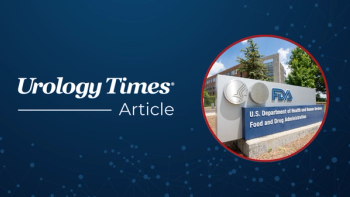
PINNACLE trial aims to confirm pilot success with BPH drug-coated balloon catheter
The drug-coated balloon catheter system is being compared with a sham device in a double-blinded randomized trial.
Following a successful pilot study, the ongoing randomized PINNACLE trial is now aiming to confirm the safety and efficacy of the Optilume™ drug-coated balloon catheter system as a treatment for men with symptomatic benign prostatic hyperplasia (BPH).
The Optilume system consists of a “a dilation catheter used to exert radial force to dilate the prostatic urethra resulting in a commissurotomy. The distal end of the catheter has a semi-compliant inflatable double lobe balloon that is coated with a proprietary coating containing the active pharmaceutical paclitaxel,” according to ClinicalTrials.gov.1
Results from the EVEREST-1 pilot study (NCT03423979) presented at the 2020 American Urological Association Virtual Experience showed that Optilume is safe and provides significant, durable objective and subjective improvements in BPH-related lower urinary tract symptoms.2
Building on this foundation, the prospective, double-blind, randomized PINNACLE trial (NCT04131907) is now accruing patients with symptomatic BPH at 18 locations in the United States. Steven A. Kaplan, MD, Mount Sinai Health System, is the principal investigator on the trial, which has a target enrollment of 162 patients. Kaplan was also the primary investigator on the EVEREST-1 pilot study.
PINNACLE is randomizing patients to either Optilume BPH catheter system or a sham device (21 Fr Optilume BPH, prostatic pre-dilation catheter [modified to prevent inflation]). There will also be a 15-patient nonrandomized pharmacokinetics arm of patients who will receive the Optilume BPH catheter system. The primary outcomes measures of the trial are the change in International Prostate Symptom Score (IPSS) from baseline to 12-months post-procedure, and the rate of major device-related serious complications.
According to ClinicalTrials.gov, to enrolled on the study patients must have symptomatic BPH and be aged 50 to 80 years; an IPSS ≥13; peak urinary flow rate (Qmax) ≥5 ml/sec and ≤12 ml/sec (with minimum voided volume of ≥ 150 ml); prostate volume 20 to 80 gm as determined by transrectal ultrasound (TRUS); prostatic urethral length ≥ 32 mm as determined by TRUS; and a history of inadequate response, contraindication, or refusal of BPH medical therapy.
There is an extensive list of
- Any prior minimally invasive intervention or surgical intervention of the prostate
- PSA ≥10 ng/ml unless prostate cancer is ruled out by biopsy
- Confirmed or suspected malignancy of prostate or bladder
- Active or history of epididymitis within the past 3 months
- Previous pelvic irradiation or pelvic trauma surgery
- Bacterial prostatitis within the last 12 months
- Non-bacterial prostatitis within the last 5 years
- Neurogenic bladder or sphincter abnormalities or neurological disorders that might affect bladder or sphincter function
- History of urinary incontinence
- Previous or current diagnosis of urethral strictures, bladder neck contracture or detrusor muscle spasms
- Previous rectal surgery, other than hemorrhoidectomy
- Use of LHRH analogs within 12 months prior to baseline assessment
- Use of Type II 5-alpha reductase inhibitor, within 3 months of baseline assessment
- Use of 5-alpha reductase within 6 months of baseline assessment
- Current bladder or prostatic urethral stones
- Current uncontrolled diabetes
The estimated primary completion date of the PINNACLE trial is June 2021 and the estimated final completion date is June 2025. The trial is being sponsored by Urotronic Inc.
Pilot Study
The EVEREST-1 Optilume pilot trial that preceded the PINNACLE trial enrolled 80 men with BPH across 6 investigational sites in Latin America.2 The study investigated 3 sizes of the balloon, described as small, medium, and large.
At the cutoff date for data analysis, 73 men had completed 1 year of follow-up. The primary end points for the study were improvement of 40% or greater on the IPSS from baseline to 3 months and major device- or procedure-related adverse event (AEs) at 3 months. Among the 79 patients evaluated at 3 months, 82.3% met the efficacy end point. Regarding the safety end point, there was only 1 major device/procedure-related AE at 3 months, consisting of 1 subject who developed stress urinary incontinence, which resolved at the 30-day follow-up.
Mean IPSS score was 22.3 at baseline and had improved to 8.3, 8.0, and 7.9 at 3, 6, and 12 months, respectively. Mean peak flow rate was 10.9 mL/sec at baseline and 19.6 mL/sec at 1 year. Improvements in both IPSS and Qmax were statistically significant.
Analyses performed with men stratified by balloon size showed that the level of symptom improvement and its durability were similar regardless of balloon size. However, maximum symptom relief was achieved by day 30 using the small balloon whereas it took 6 months to achieve maximum symptom relief with the large balloon.
Analyses of improvements in peak flow rate showed that the large balloon was associated with significant improvement within the first 30 days, but there was a slight deterioration in benefit at 1 year. Peak flow rate improvements were relatively smaller using the small and medium balloons, but peak flow still increased to about 17 mL/sec and remained stable throughout the 1-year follow-up.
Safety was favorable, and there were no changes in sexual function.
References
1. A Clinical Study to Evaluate the Safety and Efficacy of the Optilume™ BPH Catheter System in Men With Symptomatic BPH (PINNACLE). NIH US National Library of Medicine: ClinicalTrials.gov. Posted October 18, 2019. https://bit.ly/39TXWU0. Accessed August 3, 2020.
2. Kaplan S, Pichardo M, Rijo E et al. EVEREST-1: One-year Optilume BPH catheter system efficacy and safety experience. Presented at: AUA 2020 Virtual Experience. Abstract PD61-03.
Newsletter
Stay current with the latest urology news and practice-changing insights — sign up now for the essential updates every urologist needs.















